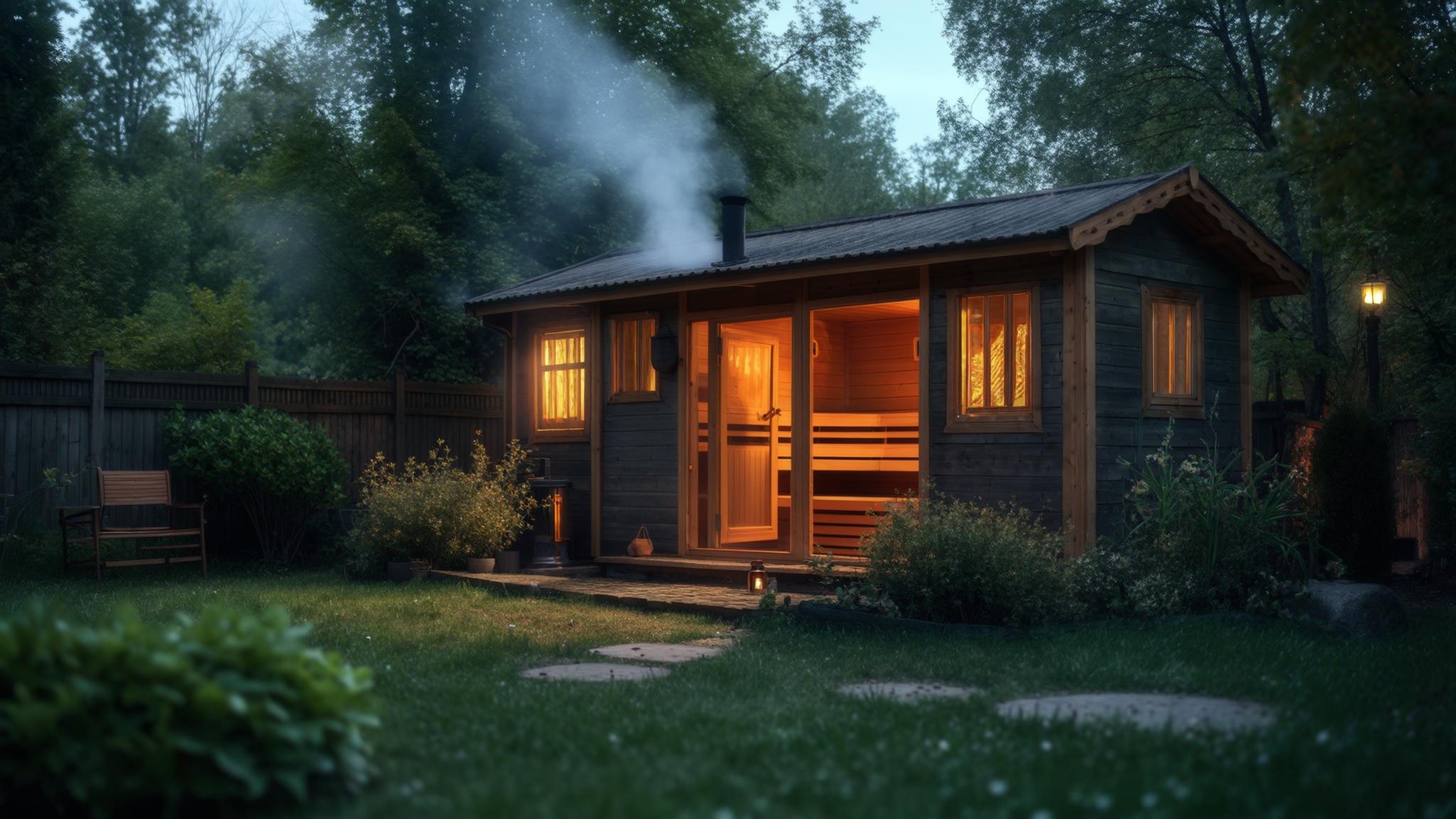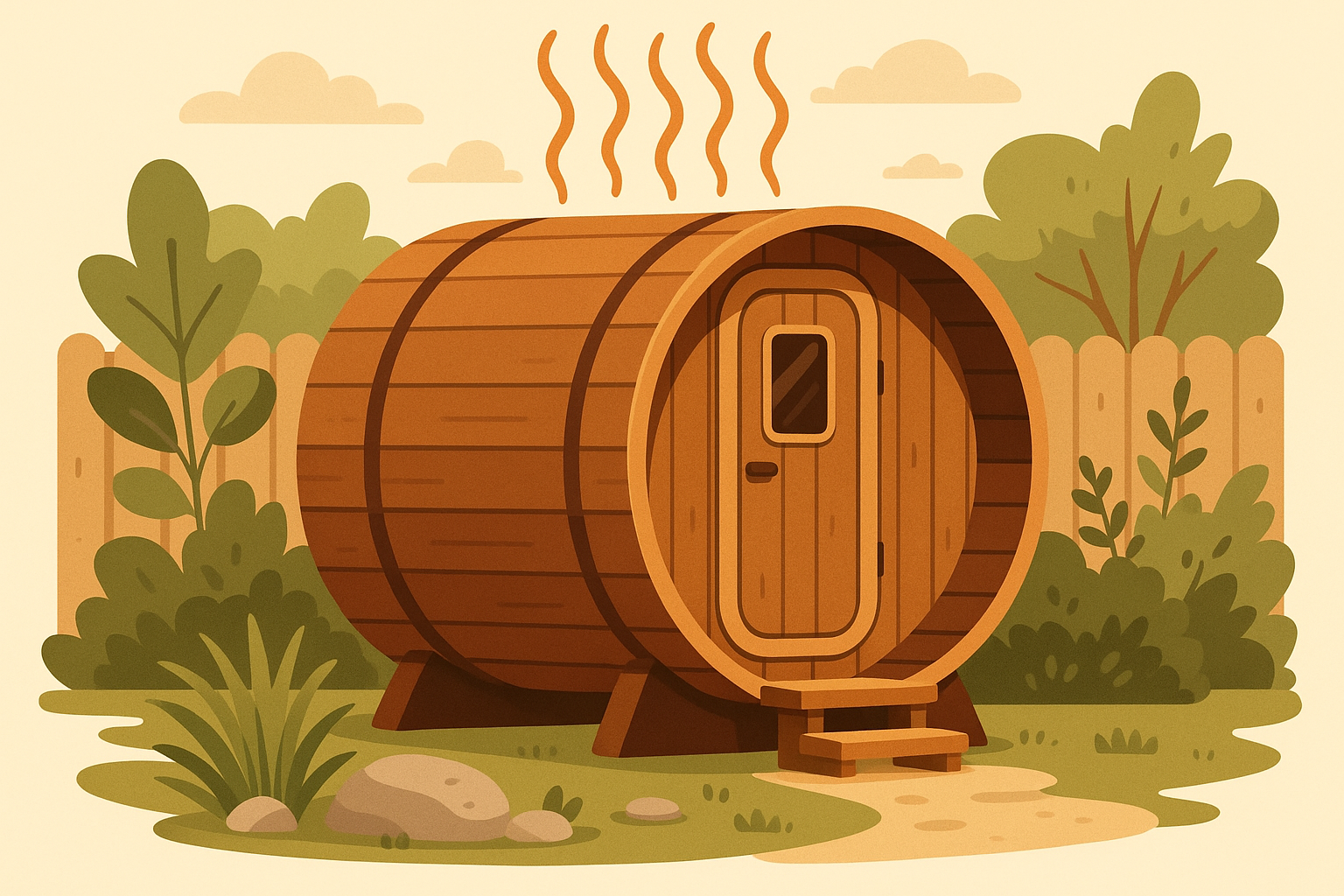
Three years ago, I watched my neighbor install what looked like the perfect backyard sauna. Beautiful cedar, professional installation, the works. Six months later, he was dealing with a soggy deck, dead plants, and a heating bill that made him wince. That’s when I learned that saunas create invisible ecosystems most people never see coming.
The outdoor sauna market has exploded recently, with research showing that regular sauna use can reduce all-cause mortality by up to 40% when used 4-7 times weekly compared to once per week usage. Foundation Health But here’s what most homeowners miss completely: their backyard sauna creates far more than just a hot room.
Your outdoor sauna generates an invisible bubble of heat, moisture patterns, and environmental changes that can either make your entire property amazing or create problems you never saw coming. I’ve watched people spend thousands on beautiful outdoor sauna installations, only to discover they accidentally turned their backyard into a swamp or killed their favorite plants.
The difference between a sauna that enhances your property and one that fights against it comes down to understanding these invisible systems. Most installation guides focus on the obvious stuff – electrical, plumbing, basic construction. They completely ignore the complex environmental relationships your sauna creates the moment you fire it up.
Table of Contents
- The Heat Bubble Your Sauna Actually Creates
- Why Your Sauna’s Location Affects Your Entire Property’s Feel
- The Underground Stuff Nobody Talks About
- How Your Sauna Can Work With Nature Instead of Against It
- Barrel Sauna Kits: What They Don’t Tell You About Assembly
TL;DR
- Your outdoor sauna creates a 15-20 foot heat bubble that you can use strategically for snow melting, extended outdoor seasons, and better outdoor living
- All that steam has to go somewhere – managing it properly prevents structural damage while creating beneficial microclimates
- Where you put your sauna affects how your entire property feels, your daily routines, and even your property value
- The underground infrastructure makes or breaks your year-round performance – and most people get it wrong
- Working with your property’s natural systems creates self-sustaining setups that reduce maintenance costs
- Barrel sauna assembly follows completely different rules than regular construction – here’s what the manuals don’t tell you
The Heat Bubble Your Sauna Actually Creates
Most people think about the heat inside their sauna, but successful backyard outdoor sauna installations create carefully managed heat bubbles that extend way beyond the walls. These invisible zones can either work for you or against you in ways that can make or break your entire outdoor space.
My friend Sarah in Minnesota discovered this by accident. Her barrel sauna kept her back patio 8-10 degrees warmer all winter. What started as a personal wellness thing turned into the best outdoor entertaining space in the neighborhood. She had no idea her sauna was doing that until she started hosting January dinner parties.
Here’s the thing – your outdoor sauna is going to create this heat bubble whether you plan for it or not. Understanding how it works helps you use it strategically instead of fighting against it. Most people discover these patterns accidentally, usually when they notice weird snow-melting shapes around their structure.
Understanding the science behind traditional Finnish sauna design principles helps inform these heat considerations, as Finnish sauna design secrets reveal centuries of evolved knowledge about thermal management and environmental integration.
Understanding Your Sauna’s Heat Zone
Your outdoor sauna’s heat influence extends about 15-20 feet in all directions, creating invisible warm zones that you can map and actually use. This heat signature affects everything from natural snow-melting areas in winter to extended outdoor season spaces that most people never think to plan for.
I spent months wondering why the snow always melted in weird patterns around my buddy’s outdoor sauna until I realized I was seeing the heat bubble in action. You can actually map this invisible zone and use it strategically for outdoor living areas, walkways, or even growing spaces.
Think of your sauna like a campfire. The heat doesn’t just stay where the fire is – it spreads out in a circle, warming everything around it. Your sauna does the same thing, but in a much more predictable pattern you can actually use.
Mapping Your Heat Signature
The invisible heat your outdoor sauna creates extends 15-20 feet in all directions, but wind patterns and nearby surfaces can redirect this warmth in ways you can predict and use. Start by understanding where this heat goes naturally, then plan features within this zone.
Start by documenting wind patterns on your property using a simple wind meter over a couple months. Mark potential heat reflection surfaces – walls, fences, large rocks that can bounce warmth around. Then plan outdoor features within this heat zone.
Your backyard sauna positioning determines how effectively you can harness these heat patterns. Consider a homeowner in Minnesota who positioned their barrel sauna 18 feet from their back patio. By mapping where the heat went during winter months, they discovered the warmth kept their outdoor dining area comfortable enough for year-round use.
This extended their outdoor entertaining season by 6-8 weeks. They added a pergola and some outdoor heaters within this zone, creating a winter outdoor living space that functions even when it’s freezing. The outdoor sauna became the anchor point for their entire cold-weather outdoor strategy.
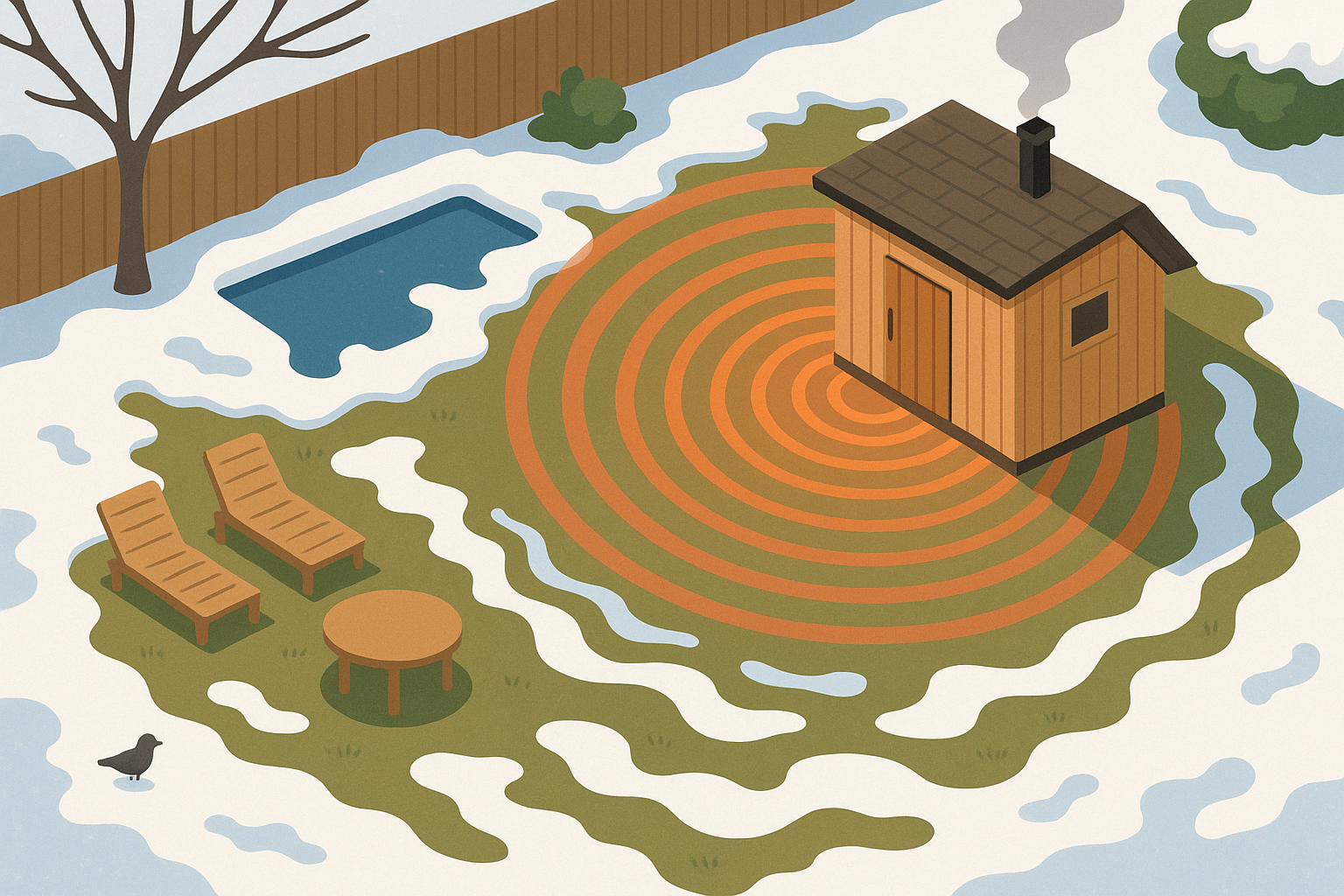
Dealing With All That Steam
The moisture your outdoor sauna pumps out creates a humidity zone that extends about 25 feet from your exit door. This vapor can either damage nearby structures or be channeled to benefit specific plants and outdoor features – but you need to manage it intentionally.
Ever notice how your outdoor furniture gets gross and humid near your sauna? Or how certain plants suddenly started thriving (or dying) after you installed it? That’s the invisible moisture ecosystem at work.
The humidity your sauna outdoor setup creates doesn’t just disappear. It’s creating a moisture zone that you need to think about. Install simple drainage channels using perforated pipes buried about 6 inches deep to direct moisture where you want it.
Create moisture-loving plant zones 10-15 feet from the sauna exit. Keep moisture-sensitive stuff – electronics, untreated wood – outside that 25-foot vapor zone. Your outdoor sauna becomes part of a smart water management system when you plan these moisture patterns correctly.
Making Your Sauna Work Year-Round
Your outdoor sauna’s relationship with seasonal changes creates opportunities that most owners never explore. Each season presents different ways to optimize your setup, from thermal banking in winter to heat management in summer.
Most people think of saunas as winter activities, but proper seasonal planning creates value throughout the entire year. The key is understanding how your sauna interacts differently with your property during each season and planning accordingly.
Winter brings extreme temperature differences that you can actually harness. Summer requires heat management strategies that most people get wrong. Spring and fall offer the sweet spots where your outdoor sauna really shines for extending outdoor seasons.
The benefits of year-round sauna use extend beyond thermal comfort, as research shows saunas are perfect for year-round enjoyment when properly integrated with seasonal landscape changes.
Winter Heat Banking
Strategic placement near stone walls, concrete slabs, or even large boulders allows your outdoor sauna to “charge” these surfaces during use. They’ll absorb heat and slowly release it for hours afterward, creating surprisingly comfortable outdoor spaces.
Here’s something most people miss: your outdoor sauna can actually charge nearby stone or concrete surfaces with heat. The warmth these surfaces release later creates comfortable outdoor spaces that work well into the evening.
Position your outdoor sauna where it can warm these surfaces during use. This heat banking effect can dramatically extend your outdoor season and create gathering spaces that stay comfortable long after your sauna session ends.
| What You Probably Have | How Long It Stays Warm | Sweet Spot Distance | Why It Matters |
|---|---|---|---|
| Concrete patio | 4-6 hours after your session | 8-12 feet away | Free patio heating |
| Stone retaining wall | 6-8 hours | 10-15 feet | Extends outdoor season |
| Fire pit area | 3-4 hours | 6-10 feet | Perfect combo spot |
| Large boulders | 5-7 hours | 12-18 feet | Natural heat storage |
| Water feature | 2-3 hours | 15-20 feet | Prevents freezing |
Summer Heat Management
Summer sauna sessions don’t have to be torture. Your outdoor sauna actually has advantages over indoor units when you understand proper heat management. Natural airflow and strategic shading create conditions that many people prefer to climate-controlled indoor spaces.
Advanced shading and ventilation techniques can make summer outdoor sauna sessions more enjoyable than indoor alternatives. The key is working with natural airflow patterns rather than fighting them.
Design ventilation systems that capture prevailing breezes. Install adjustable shading that blocks direct sun while maintaining airflow. Your outdoor sauna can be more comfortable in summer than winter when you plan these systems correctly.
Spring and Fall Sweet Spots
Spring and fall offer unique opportunities to extend outdoor seasons through strategic outdoor sauna scheduling and complementary outdoor activities. These transition seasons provide optimal conditions for integrating sauna use with other outdoor activities.
Your outdoor sauna really shines during these shoulder seasons. The mild temperatures create perfect conditions for longer sessions and easier transitions between hot and cool environments. Most people discover their favorite sauna experiences happen during these periods.
Plan outdoor activities that take advantage of these optimal conditions. Your outdoor sauna becomes the centerpiece for extended outdoor living when you understand how to maximize these transition periods.
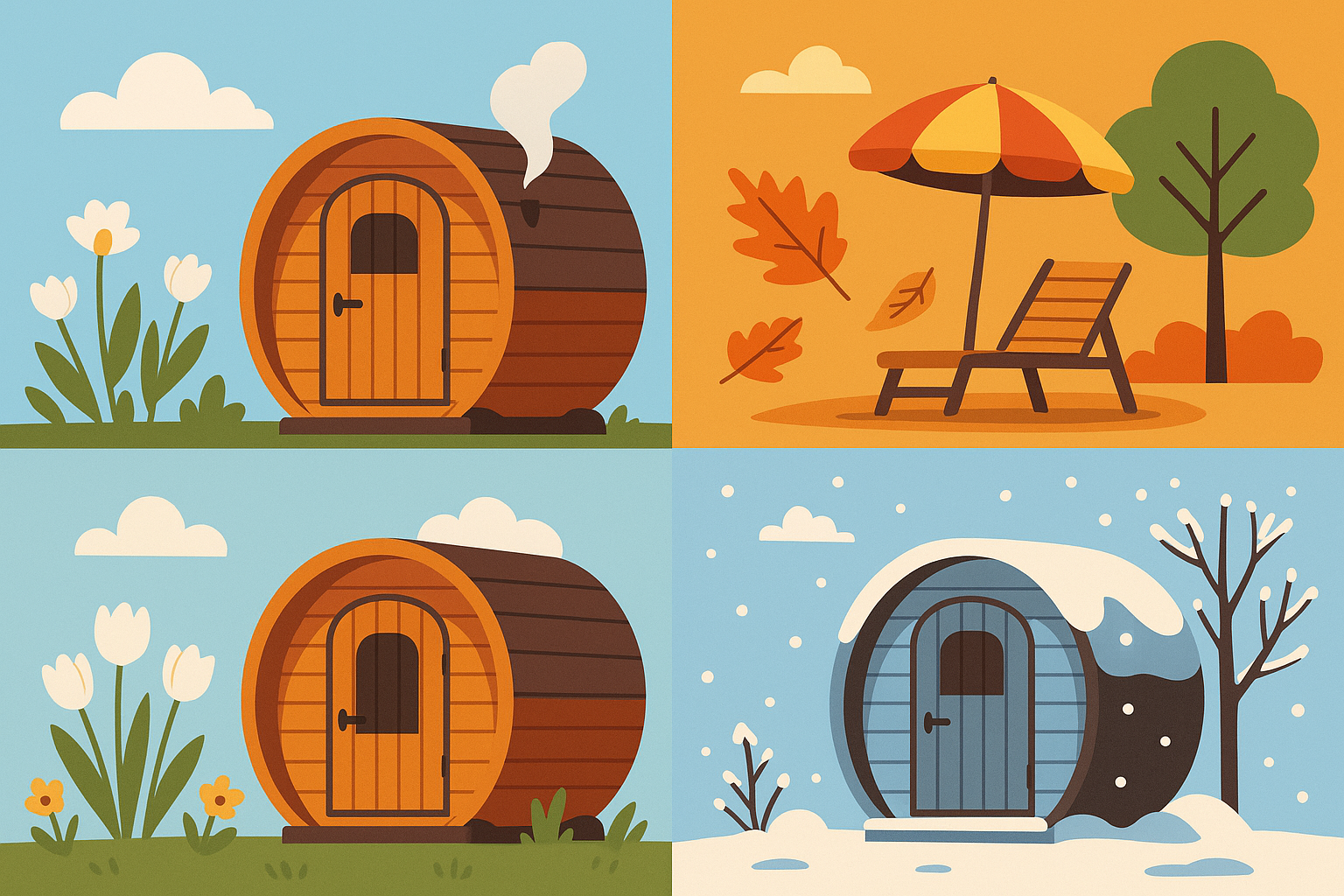
Why Your Sauna’s Location Affects Your Entire Property’s Feel
The location of your outdoor sauna creates invisible boundaries and energy flows that dramatically impact how your entire property feels and functions. This goes way beyond basic privacy and convenience – your sauna location influences how you and your guests experience your entire outdoor space.
I’ve walked through properties where the outdoor sauna placement felt completely wrong, even though I couldn’t immediately explain why. Then I’ve experienced installations where the sauna seemed to organize and anchor the entire outdoor space perfectly. The difference comes down to understanding how placement affects movement patterns, sight lines, and the overall vibe of your property.
Your sauna in backyard positioning determines whether it becomes an isolated structure or an integrated element that enhances your property’s flow. When you get this right, your sauna becomes a focal point that makes your entire outdoor space feel more intentional and connected.
Creating Privacy That Actually Works
Successful outdoor sauna installations create privacy zones that make you feel simultaneously secluded and connected to nature. This requires strategic placement of screening elements that maintain important sight lines for safety while creating the feeling of complete privacy.
Privacy isn’t just about blocking views – it’s about creating the right kind of visual boundaries. Your outdoor sauna needs to feel like a sanctuary without feeling like a bunker. The sweet spot is somewhere between complete exposure and total isolation.
Most people approach outdoor sauna privacy wrong. They either create fortress-like installations that feel claustrophobic, or they place their sauna in completely exposed locations that never feel comfortable to use.
Smart Visual Barriers
Strategic placement of screening elements creates the feeling of complete privacy while maintaining important sight lines for safety and connection to your home. This visual choreography requires mapping sight lines from neighboring properties at different times of day.
Map sight lines from neighboring properties at different times of day – shadows change everything throughout the day. Create a “privacy progression” using varied height plantings or structures. Your outdoor sauna should feel progressively more private as you approach it.
Install subtle lighting that maintains privacy while ensuring safe navigation after dark. The goal is creating visual barriers that work psychologically without creating actual isolation from your home and property.
The growing trend of backyard wellness partnerships is making sophisticated privacy design more accessible. “Soake Pools and Harbor Saunas Team Up for Backyard Wellness” Designers Today reports that companies are now offering integrated solutions that consider privacy, thermal management, and aesthetic cohesion as part of complete backyard wellness systems.
Your outdoor sauna privacy design should feel intentional but not obvious. The best installations create privacy through layered elements that feel natural and unforced.
Natural Sound Management
Sound privacy is just as important as visual privacy, maybe more so. The goal is creating an acoustic sanctuary where you can actually hear yourself think – or not think, depending on your sauna philosophy.
Positioning your outdoor sauna to leverage natural sound barriers and white noise sources creates an acoustic sanctuary that enhances the meditative experience. This involves identifying existing sound sources and using structures as sound deflectors.
Identify natural sound sources – water features, rustling trees, even distant traffic patterns that create white noise. Position the outdoor sauna to use existing structures as sound deflectors. Plan complementary sound elements that mask unwanted noise without creating artificial soundscapes.
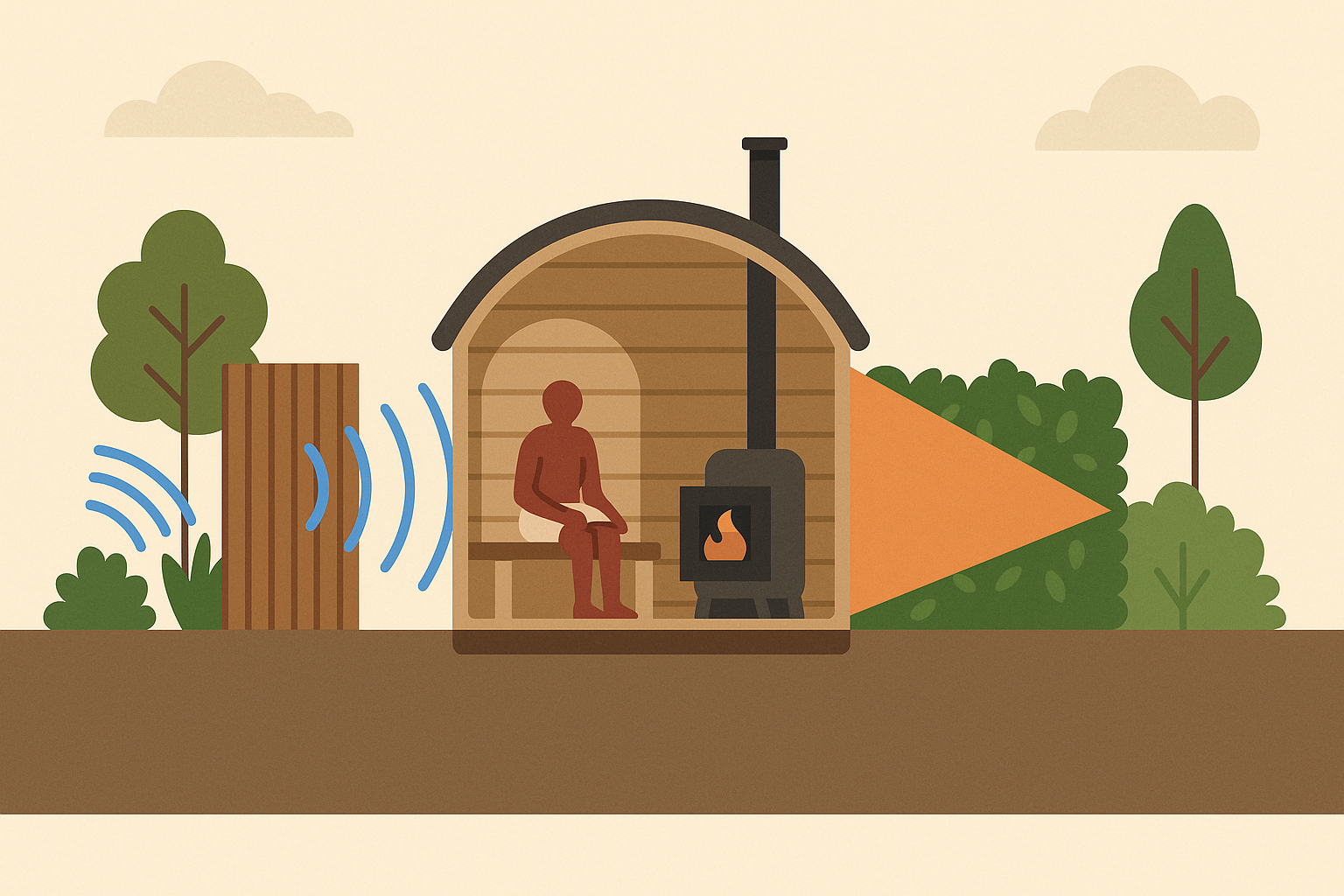
Designing the Journey to Your Sauna
The walk to your outdoor sauna isn’t just transportation – it’s the beginning of the ritual. This transition from your daily headspace to sauna mindset needs to be intentional, not accidental.
The journey to and from your outdoor sauna becomes a crucial part of the experience. Most people underestimate how important this approach sequence is to the overall experience. Your outdoor sauna session actually begins the moment you start walking toward the structure.
The ritual aspect of sauna use extends beyond the structure itself, and understanding sauna routine science and method can inform how you design these transitional spaces for maximum psychological benefit.
Creating the Right Approach
The path to your outdoor sauna should create a gradual mental transition from daily concerns to relaxation focus, using changes in materials, elevation, and visual cues. This approach sequence requires at least three distinct zones or material changes.
Design the approach path with at least three distinct “zones” or material changes. Maybe you start on regular pavement, transition to gravel, then finish on wooden decking. Each change signals your brain that you’re moving into a different kind of space.
Your outdoor sauna approach should feel like a progression, not just a walk across the yard. The materials under your feet, the views you see, the sounds you hear – all of these should change as you move toward the sauna.
Planning Your Cool-Down Space
Your post-sauna state is unique – you’re physically heated but mentally relaxed, often slightly disoriented, and definitely not ready to jump back into normal life immediately. Your cool-down space needs to accommodate this specific condition.
Post-sauna spaces need to accommodate the unique physical and mental state you experience after sessions. This involves creating multiple cool-down options and discrete storage solutions for towels and robes.
Create multiple cool-down options: shaded seating for gradual cooling, open air exposure for quick temperature drops, water features for contrast therapy. Plan storage for towels and robes that’s accessible but discrete.
A Colorado homeowner created a three-stage approach: starting with a flagstone path from their house, transitioning to river rock through a small Japanese garden, and ending with cedar decking leading to their outdoor sauna. Post-sauna, they installed a cold plunge tub 8 feet from the exit, a covered relaxation area with cushioned seating 15 feet away, and discrete storage benches built into the decking. This design allows for immediate cold therapy, gradual cool-down, or extended relaxation depending on their needs.
The Underground Stuff Nobody Talks About
The most successful outdoor sauna installations rely on hidden infrastructure systems that most DIY guides completely ignore. I’ve seen beautiful outdoor sauna installations fail because nobody thought about what was happening below ground.
The visible structure is only half the story – the underground systems determine whether your sauna performs reliably or becomes a constant source of problems. These hidden networks involve utility connections and foundation work that goes far beyond basic electrical service.
Most installation guides focus entirely on above-ground construction while completely ignoring what happens underground. This creates expensive retrofit situations when owners discover their sauna needs infrastructure that wasn’t planned during initial construction.
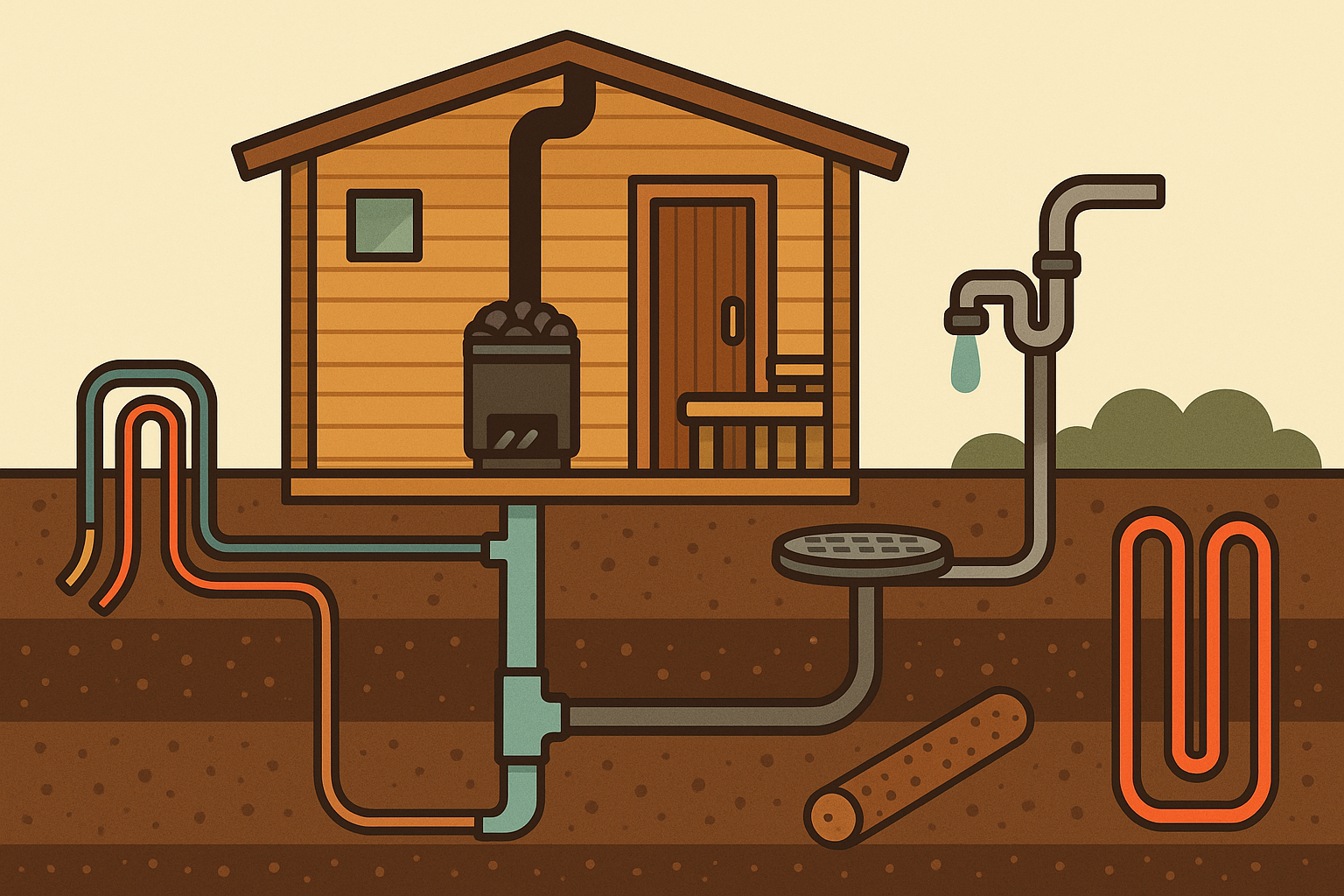
Smart Underground Connections
Modern outdoor sauna installations require underground connections that extend far beyond basic electrical service. These systems create opportunities for smart home integration, automated systems, and efficiency improvements that most people never consider.
Your outdoor sauna can tap into ground temperature stability, smart drainage systems, and data networks that transform it from a simple hot room into an intelligent system. These underground connections determine long-term performance and maintenance requirements.
The investment in proper underground infrastructure pays dividends for decades. When your outdoor sauna connects to well-designed underground systems, it operates more efficiently and requires less maintenance than installations that rely only on above-ground connections.
Using Ground Temperature to Your Advantage
Most people think geothermal is only for big houses, but you can use the same principle on a smaller scale for your outdoor sauna. The ground temperature stays remarkably stable year-round, usually around 50-55°F below the frost line.
Buried air intake systems can pre-condition incoming air using stable ground temperatures, dramatically improving efficiency and comfort in extreme weather. This involves installing perforated intake pipes below the frost line connected to simple heat exchanger systems.
Dig test holes to determine frost line depth in your area. Install perforated intake pipes 18 inches below frost line, extending 50 feet from the sauna. Connect to a simple heat exchanger system for incoming air pre-conditioning. Your heater won’t have to work nearly as hard in winter.
Smart Water Management
Why dump perfectly good water when you can use it? Sauna wastewater is actually pretty clean – it’s mostly just warm, soapy water that plants can use after basic filtration.
Advanced drainage systems can capture and redirect sauna wastewater to irrigation systems, creating closed-loop water management. This involves greywater collection, simple filtration systems, and routing filtered water to designated irrigation zones.
Install a greywater collection system beneath the outdoor sauna floor. Connect to a simple filtration system using sand and gravel beds. Route filtered water to designated irrigation zones for drought-tolerant plants. You’ll reduce your water bill and create a more sustainable system.
Data and Monitoring Networks
Smart home integration isn’t just about convenience – it’s about safety and efficiency. Being able to monitor your outdoor sauna remotely means you can catch problems before they become expensive repairs.
Underground conduits for internet, monitoring systems, and smart home integration enable remote monitoring and automated systems that enhance safety and convenience. This includes temperature sensors, humidity monitoring, and usage tracking capabilities.
Run conduit for ethernet cables alongside electrical service. Install temperature and humidity sensors connected to home automation systems. Set up remote monitoring for safety alerts and usage tracking. You’ll know if something’s wrong before you even walk outside.
Foundation Work That Actually Matters
Your outdoor sauna foundation isn’t just holding up your structure – it’s managing massive temperature swings that regular buildings never experience. Standard foundation techniques won’t handle these thermal cycles without problems.
The foundation system becomes crucial for managing heat transfer, moisture control, and long-term structural stability in ways that standard construction doesn’t address. This involves thermal management and moisture control systems.
Foundation work for outdoor saunas prevents heat loss while managing thermal expansion and contraction cycles unique to sauna structures. These specialized techniques extend structural life and improve energy efficiency significantly.
Managing Thermal Expansion
Your foundation manages temperature swings that regular buildings never experience. Standard foundation insulation won’t cut it for outdoor sauna applications because of the extreme heat cycles.
Specialized insulation techniques at the foundation level prevent heat loss while managing thermal expansion and contraction cycles unique to sauna structures. This requires closed-cell foam insulation and continuous vapor barriers extending beyond the foundation footprint.
Install closed-cell foam insulation around the entire foundation perimeter. Create a continuous vapor barrier that extends 2 feet beyond the foundation footprint. Install French drains with monitoring ports to track moisture levels over time.
Dealing With Moisture Underground
Moisture doesn’t just disappear – it migrates through your foundation and can cause problems years later. The high-humidity cycles in outdoor sauna installations create moisture dynamics that standard construction doesn’t account for.
Advanced vapor barrier systems extend below grade to manage the complex moisture dynamics created by high-heat, high-humidity cycles. These systems prevent long-term structural damage while maintaining proper drainage.
Design vapor barrier systems that extend below grade and manage moisture migration patterns. Install monitoring systems that track moisture levels in foundation materials over time. Your outdoor sauna foundation needs to handle moisture dynamics that regular structures never encounter.
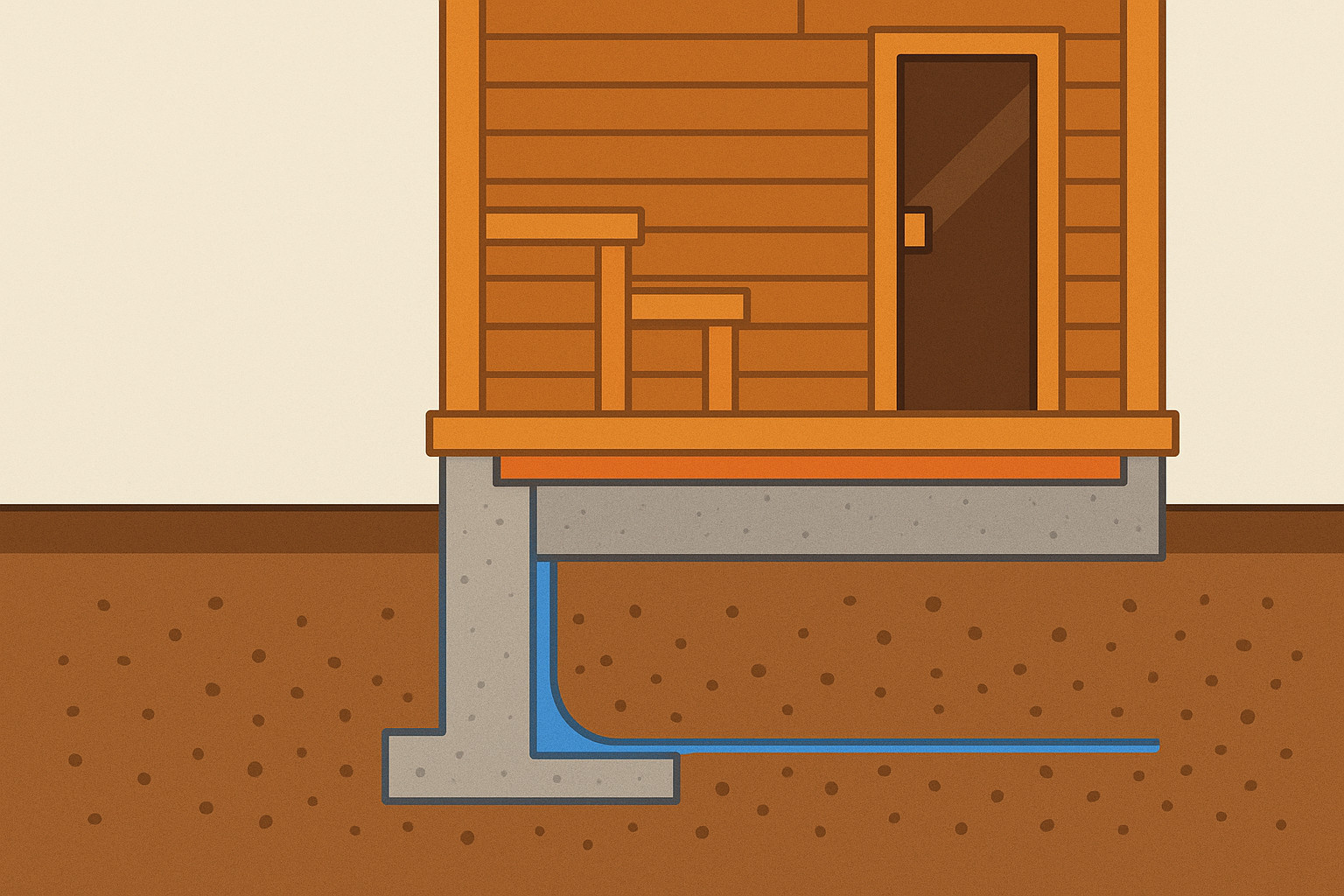
How Your Sauna Can Work With Nature Instead of Against It
The most transformative outdoor sauna installations function as elements that enhance and connect existing landscape features. Instead of imposing a structure on your landscape, you’re creating a hub that supports and amplifies natural systems.
I’ve seen outdoor sauna installations that feel completely foreign to their environment, and others that seem to have grown naturally from the landscape itself. The difference comes down to understanding how your structure can support rather than disrupt existing relationships in your yard.
Your sauna for backyard installations can become catalysts for environmental enhancement when designed with ecosystem integration in mind. This integration approach requires thinking beyond the structure itself to consider how your outdoor sauna affects soil health, water cycles, wildlife patterns, and plant communities.
Creating a holistic approach to backyard wellness means considering stunning outdoor sauna ideas that integrate seamlessly with existing landscape features and natural systems.
Working With Natural Systems
Your outdoor sauna generates significant amounts of heat and water that can be channeled into productive uses. Instead of treating these as waste products, you can treat them as resources for other systems.
Integrating your outdoor sauna into natural principles creates self-sustaining systems that reduce maintenance while enhancing the natural environment. This involves heat recovery and water cycle integration that create closed-loop management systems.
When done correctly, your sauna becomes part of a larger living system that gives back to your property instead of just consuming resources.
Heat Recovery Gardens
All that heat your outdoor sauna produces doesn’t have to be waste. You can channel it into growing areas that extend your growing season and create unique microclimates for plants that wouldn’t normally thrive in your area.
Channeling waste heat and moisture into specialized growing areas can extend growing seasons and create unique microclimates for specialty plants. This involves designing raised beds positioned to receive radiant heat and installing simple heat exchangers for greenhouse spaces.
Design raised beds positioned to receive radiant heat from sauna walls. Install simple heat exchangers to warm greenhouse spaces or cold frames. Create composting areas that benefit from controlled heat and moisture inputs. Your garden will thank you.
Research shows that sauna bathing can increase norepinephrine by 86% and prolactin by 510% after just 20-minute sessions twice weekly, demonstrating the powerful physiological effects that extend beyond the structure itself. Foundation Health This hormonal response creates an energy signature that can influence the entire ecosystem around your outdoor sauna.
Water Cycle Integration
Water management doesn’t have to be complicated or expensive. Simple systems can capture, process, and reuse water in ways that benefit your entire property.
Sauna operations can be integrated into rainwater collection, greywater systems, and natural water features to create closed-loop water management. This involves installing gutters and downspouts, creating natural filtering areas, and designing water features that benefit from warm discharge water.
Install gutters and downspouts to direct rainwater to storage systems. Create natural filtering areas that process and filter sauna wastewater naturally. Design water features that benefit from the warm water discharged after cleaning.
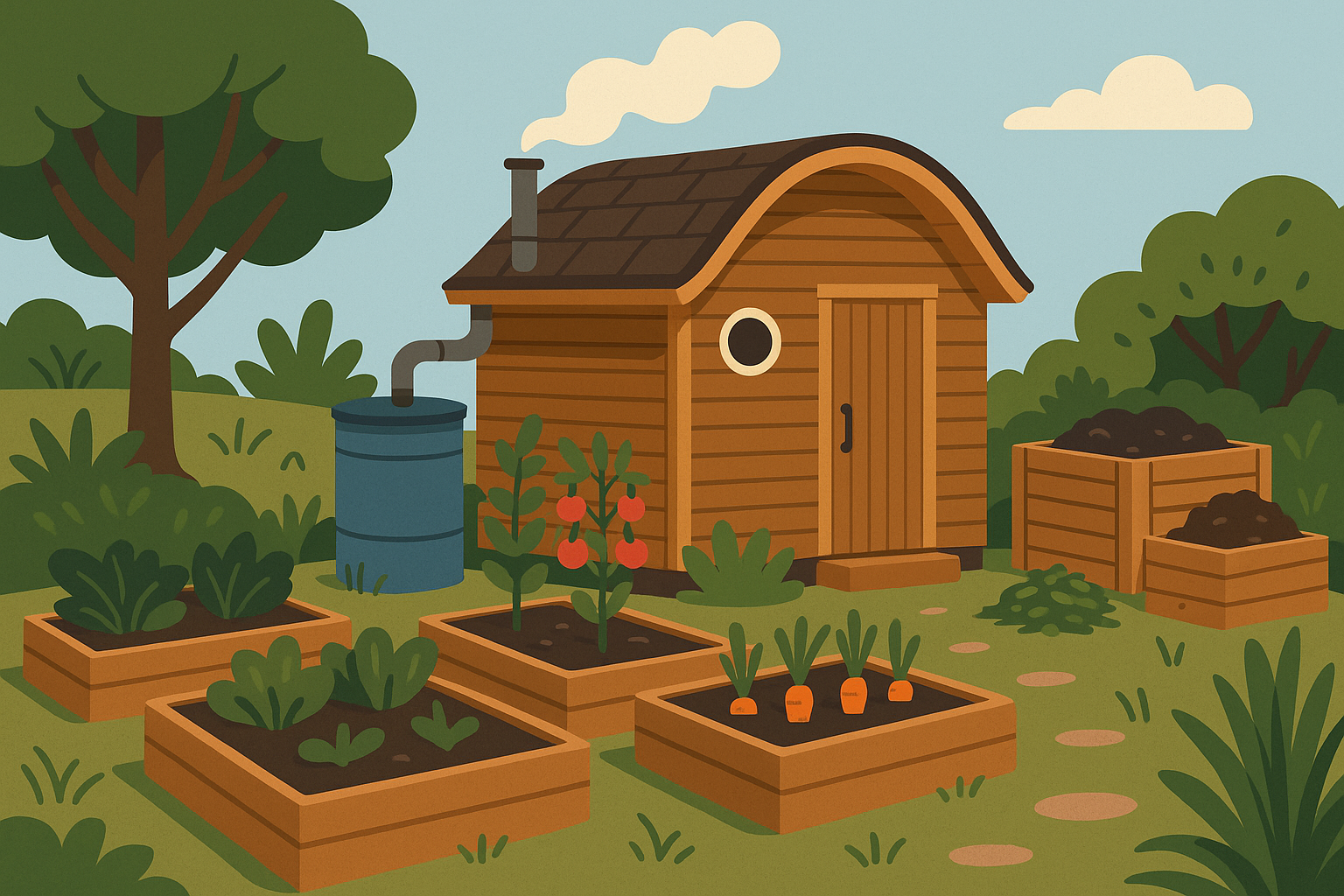
Supporting Local Wildlife
Your outdoor sauna can become a positive element in local wildlife corridors when positioned and landscaped thoughtfully. Instead of disrupting animal movement patterns, well-designed installations can create habitat and observation opportunities.
Thoughtful outdoor sauna placement and landscaping can enhance rather than disrupt existing wildlife patterns, creating observation opportunities and supporting biodiversity. This involves creating pollinator pathways and integrating bird habitat while maintaining appropriate boundaries.
Wildlife integration requires understanding existing movement patterns and designing your outdoor sauna installation to support rather than interrupt these natural flows. The warm microclimate your sauna creates can actually benefit local wildlife when managed correctly.
Creating Pollinator Support
The warm microclimate around your outdoor sauna creates opportunities to support pollinators with extended blooming seasons. Native plants that might struggle in your normal climate can thrive in these warmer zones.
The warm microclimate around your outdoor sauna can support extended blooming seasons for pollinator plants, creating vital habitat corridors. This requires researching native plants that benefit from warm microclimates and monitoring ecosystem changes.
Research native plants that benefit from warm microclimates. Install discrete wildlife cameras to monitor and document ecosystem changes. Create seasonal feeding and watering stations that complement sauna use patterns.
Studies show that regular sauna use can reduce C-Reactive protein levels, a marker of chronic inflammation, with more frequent use correlating to lower detectable CRP levels among 2,000 Finnish men studied. Foundation Health This anti-inflammatory effect extends to the surrounding ecosystem, creating healthier soil conditions that benefit native plant communities.
Bird Habitat Integration
Birds are surprisingly adaptable to human activity if you give them the right setup. Strategic habitat placement can create amazing wildlife observation opportunities without interfering with your sauna experience.
Strategic placement of nesting boxes and water features near your outdoor sauna can create wildlife observation opportunities while maintaining appropriate boundaries. This involves understanding wildlife behavior patterns and creating observation opportunities that don’t interfere with sauna use.
A Pacific Northwest homeowner installed native bird boxes 25 feet from their outdoor sauna, positioned to take advantage of the thermal updrafts created by the structure. They planted native berry bushes in the warm microclimate zone and installed a small recirculating water feature using filtered sauna wastewater. Within six months, they documented 12 new bird species visiting their property, including several that don’t typically overwinter in their area but were drawn to the consistently warmer microhabitat.
Barrel Sauna Kits: What They Don’t Tell You About Assembly
The barrel sauna kit market has exploded in 2025, with industry experts calling it “peak sauna in mainstream culture.” “Once again, 2025 is the year of the sauna” Field Mag reports that barrel saunas are becoming the most photogenic and beginner-friendly DIY option, with most kits designed for assembly by amateurs in half a day.
But here’s what they don’t tell you – barrel construction isn’t just rectangular construction bent into a circle. It’s a completely different structural system with its own rules. Most people approach it using regular building thinking and run into problems they could have avoided.
Your outdoor sauna kit assembly success depends on understanding that barrel construction follows completely different rules than rectangular building. The curved shape means the wood moves differently as it heats up and cools down, and if you don’t account for this, you’ll have serious problems later.
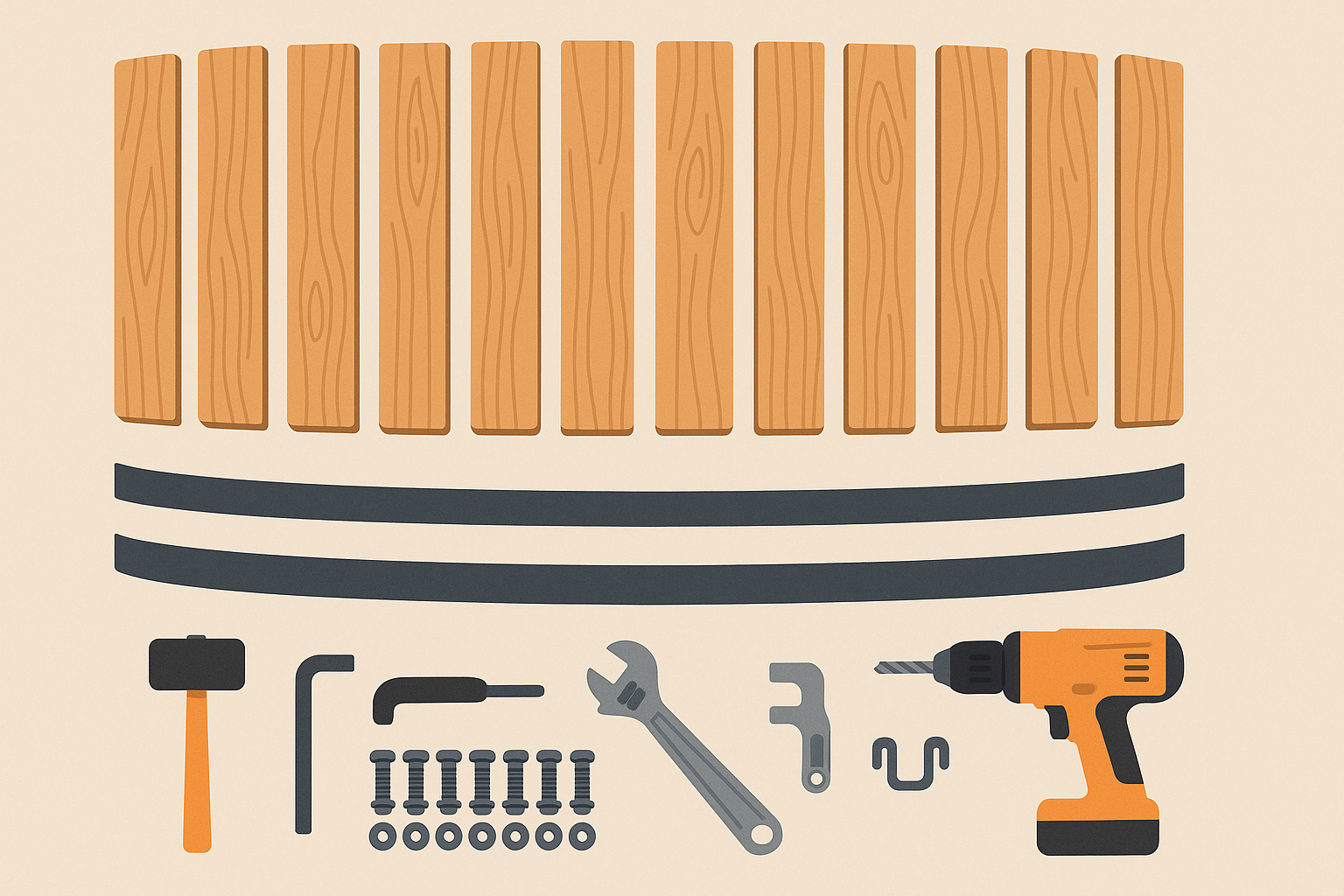
Understanding Barrel Construction
Barrel sauna kits require specialized assembly techniques that differ completely from rectangular sauna construction. The curved barrel construction creates unique wood movement patterns requiring specialized techniques during assembly and seasonal adjustments.
While barrel saunas offer unique aesthetic appeal, understanding the fundamental differences between dry vs wet sauna science helps inform proper assembly techniques for optimal performance regardless of barrel or rectangular design.
Allow the wood pieces to acclimate to your local humidity for 2-3 weeks before assembly. Use progressive tightening – tighten bands in three stages over the first month. Mark optimal tension points on bands for seasonal adjustments.
Managing Wood Movement in Curves
Curved structures expand and contract differently than straight walls . A barrel sauna can change diameter by 2-3 inches between summer and winter, and if you don’t plan for this, you’ll have serious problems.
Barrel saunas expand and contract in complex patterns that can cause catastrophic failure if not properly managed during assembly. This requires installing expansion joints, using flexible sealants, and planning for significant diameter changes between seasons.
Install expansion joints at the quarter points of the barrel circumference. Use flexible sealants rather than rigid caulking at all curved joints. Plan for 2-3 inches of total diameter change between summer and winter.
| Sauna Size | Summer Diameter | Winter Diameter | Band Adjustment | Expansion Joints |
|---|---|---|---|---|
| 6ft Length | 72″ | 69-70″ | 2-3 notches | 4 points |
| 8ft Length | 72″ | 69-70″ | 2-3 notches | 4 points |
| 10ft Length | 72″ | 69-70″ | 3-4 notches | 6 points |
| 12ft Length | 72″ | 68-70″ | 3-4 notches | 6 points |
Assembly Timeline That Actually Works
Your outdoor sauna kit assembly timeline needs to account for wood acclimation and progressive tightening. Rushing this process creates structural problems that become expensive to fix later.
Barrel Sauna Assembly Checklist:
- Allow staves to acclimate for 2-3 weeks
- Check all hardware for completeness
- Prepare level foundation surface
- Install support cradles first
- Progressive band tensioning (3 stages)
- Mark optimal tension points
- Test door alignment before final assembly
- Install electrical connections (licensed electrician)
- Apply exterior finish if required
- Schedule first seasonal adjustment
Kit Customization Strategies
Modern outdoor sauna kits offer extensive customization options that most buyers never explore, missing opportunities to create truly personalized installations. The backyard sauna kit market offers customization options that most buyers don’t know about.
Here’s where things get interesting – you’re not locked into one manufacturer’s vision of what your sauna should be. Mixing components from different suppliers can solve specific problems or create unique features, but you need to understand what you’re doing.
Mixing Components from Different Manufacturers
Combining elements from different kit manufacturers can create unique solutions, but requires understanding compatibility standards and structural implications. This approach allows for creative problem-solving but demands careful research and planning to avoid compatibility issues.
Research component compatibility before ordering from multiple suppliers. Check dimensional standards, connection methods, and material specifications. Document everything for warranty purposes because you’re essentially creating a custom hybrid system.
Performance Upgrades During Assembly
The time to upgrade your kit isn’t after you’ve built it – it’s during assembly when you have access to everything. Adding advanced insulation, smart ventilation, or upgraded heating systems is infinitely easier when the walls are still open.
Kit structures can be enhanced with advanced insulation, ventilation, and heating systems that weren’t originally designed for the base kit. Planning these upgrades during initial assembly rather than retrofitting saves time, money, and ensures better integration.
Plan electrical and ventilation upgrades during initial assembly rather than retrofitting. Research which upgrades actually provide value versus marketing hype. Document all modifications for warranty and insurance purposes.
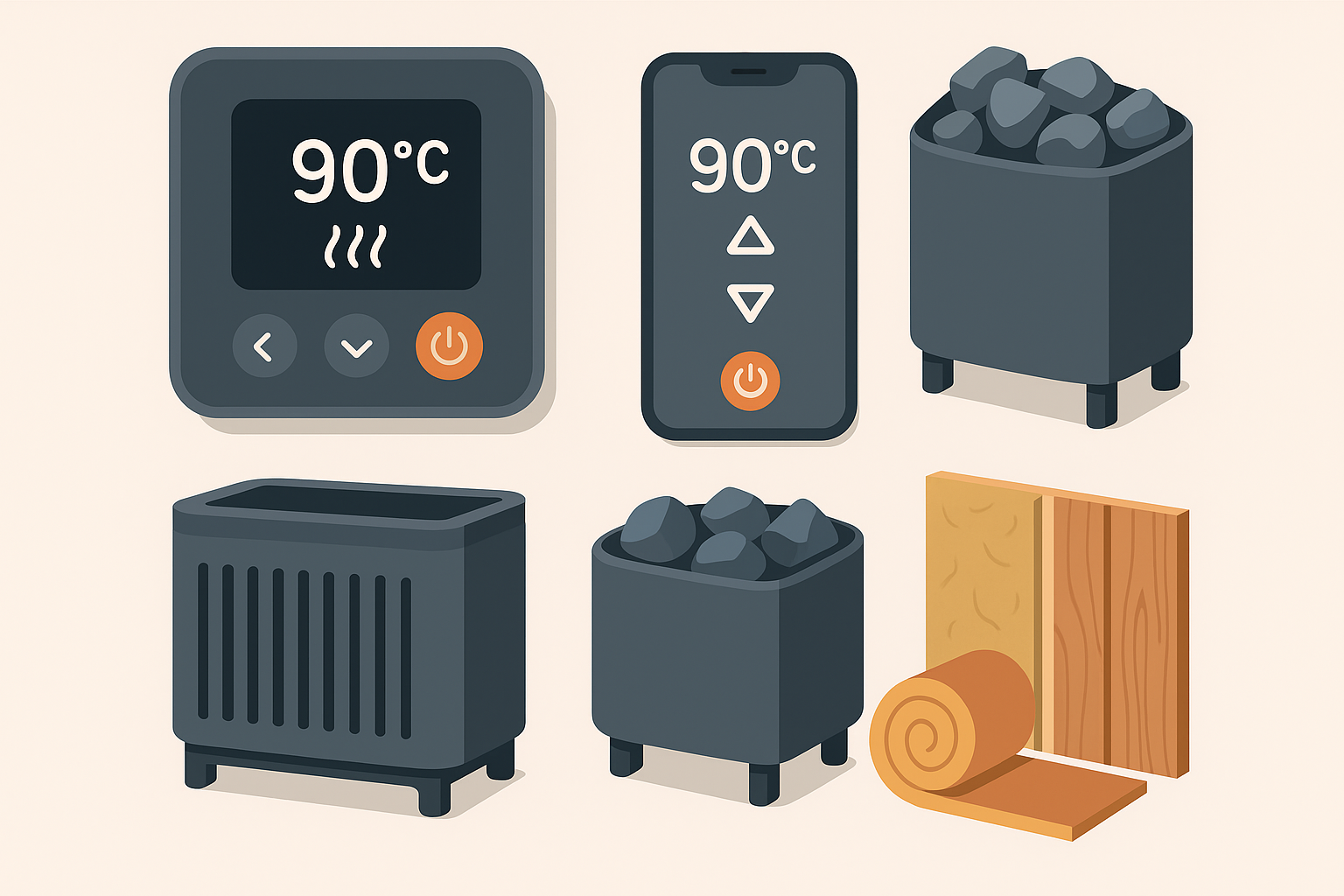
How HETKI Sauna Simplifies These Complex Considerations
The complexity we’ve covered here might feel overwhelming, but this is exactly why working with experienced sauna designers matters. HETKI Sauna’s approach to authentic Finnish sauna design addresses many of the sophisticated integration challenges discussed throughout this guide.
HETKI Sauna’s emphasis on the sauna as a sacred space reflects understanding that goes beyond basic construction, incorporating site-specific planning and consultation that addresses hidden infrastructure and ecosystem integration needs. Their connection to authentic Finnish tradition brings centuries of evolved understanding about how these structures should relate to their natural environment.
Their custom design tool enables the kind of site-specific planning that successful microclimate architecture requires. More importantly, their direct consultation approach (info@hetkisauna.com) ensures that the hidden infrastructure and integration challenges we’ve discussed can be properly addressed during the planning phase, not discovered as expensive problems later.
What sets HETKI apart is their understanding that an outdoor home sauna isn’t just a backyard addition – it’s a transformative element that should enhance your property’s entire living ecosystem. Their Hetki Collection reflects this philosophy, offering design ensembles that consider how your sauna will function within your larger outdoor environment.
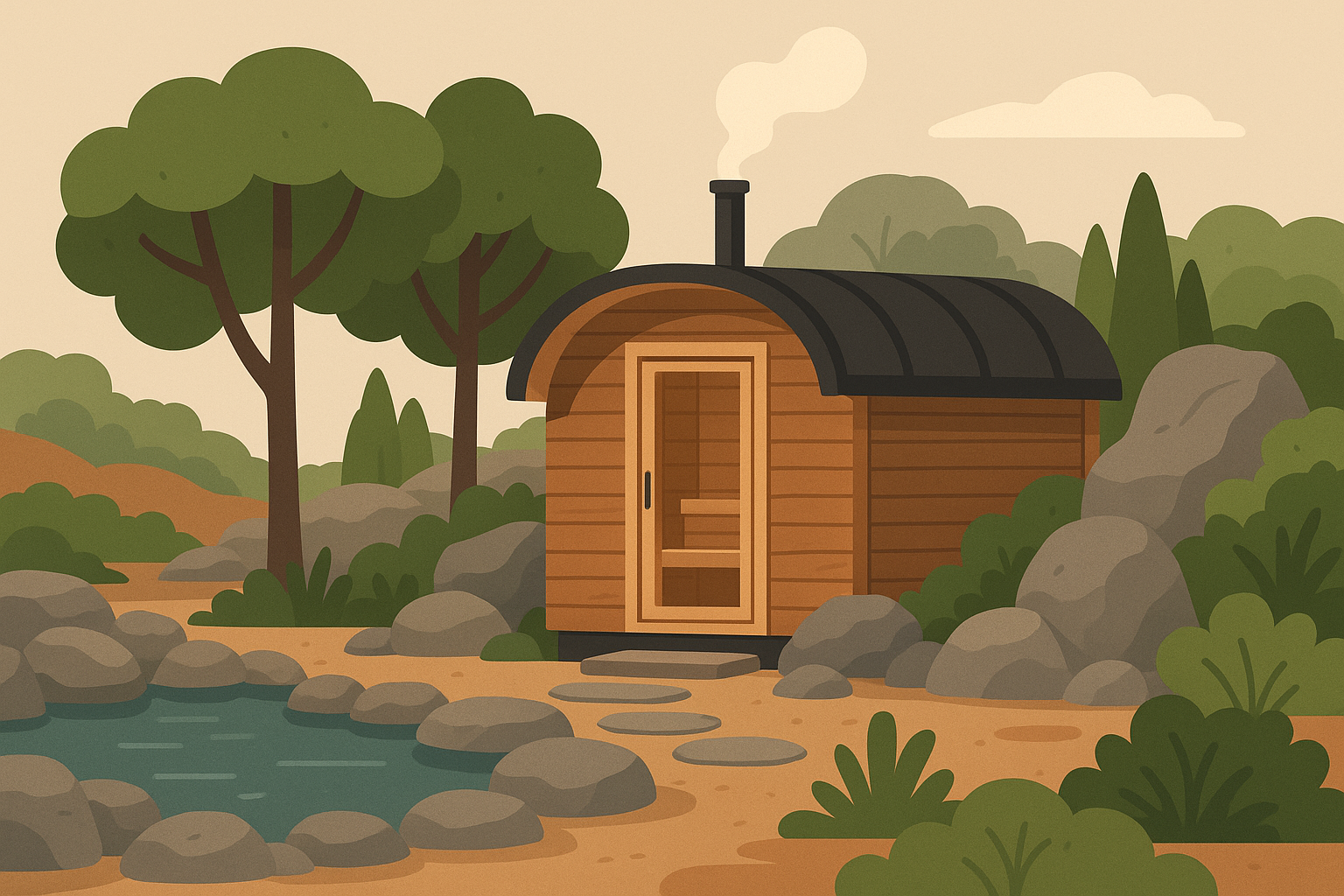
Final Thoughts
Creating a successful backyard sauna installation requires understanding the invisible systems and relationships that extend far beyond the structure itself. From heat bubbles and moisture management to underground infrastructure and ecosystem integration, these hidden complexities determine whether your sauna becomes a true enhancement to your property or just another outdoor structure.
Your backyard sauna is never just about the heat – it’s about creating a living system that works with your property’s existing environment. The heat zones, steam management, underground infrastructure, and ecosystem integration we’ve covered here represent the difference between a sauna that fights against its environment and one that enhances it.
Most people focus on the visible elements – the wood, the heater, the benches – while completely missing the invisible systems that determine long-term success. Understanding these hidden complexities upfront saves you from expensive retrofits and disappointing performance later.
I know this sounds like a lot to think about. When I first learned about all these invisible systems, I felt like I needed an engineering degree just to enjoy a hot sauna. But here’s the thing – you don’t need to be perfect. Understanding even a few of these concepts will put you way ahead of most sauna owners.
The investment in proper planning pays dividends for decades. When your sauna functions as a keystone element that enhances your entire outdoor space, creates beneficial microclimates, and integrates seamlessly with your property’s natural systems, you’ve created something that goes far beyond a simple backyard addition.
Whether you’re planning your first sauna or upgrading an existing installation, remember that the most successful projects are those that work with nature rather than against it. Your sauna can be a catalyst for transforming your entire outdoor living experience – if you understand the hidden ecosystem it creates.
The best sauna installation I ever saw wasn’t the most expensive or the most technically perfect. It was the one where the owner took time to understand how their sauna would live in their specific backyard. Your sauna doesn’t have to be Instagram-perfect – it just has to work for you and your property.

